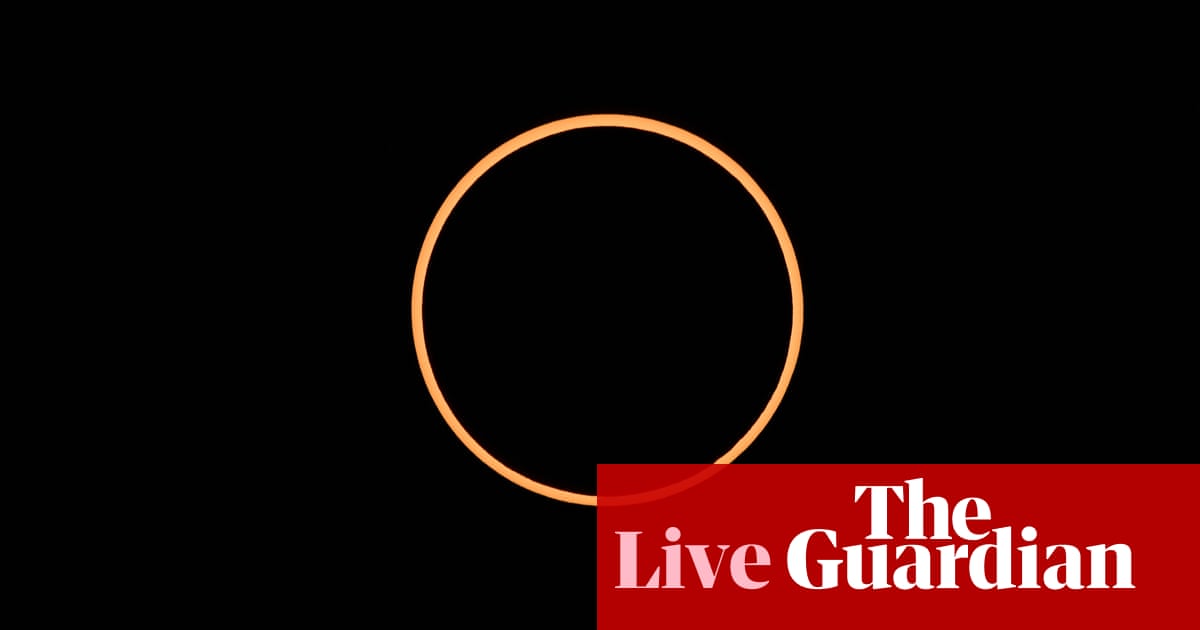
Annularity reaches Texas
Cities in Texas, the final state that will experience the full “ring of fire” effect from the solar eclipse today, are beginning to see annularity.
Children at a lively watch party in Kerriville counted down to the moment the moon passed fully in front of the sun, and cheered loudly when it did. Baily’s beads (see previous post) were visible around the moon.
The fiery highlight of the eclipse has now been visible in all eight mainland states that will experience it. Viewers in states outside the path of annularity, meanwhile, continue to enjoy the sight of varying degrees of partial eclipse.
The eclipse will shortly depart the US coast into the Gulf of Mexico, and towards the Yucatan peninsula and countries in South and Central America.
We’re closing down our annular solar eclipse blog now, thank you for joining us.
The spectacular “ring of fire” experienced by viewers in eight states has moved off the Texas coast towards the Yucatan peninsula and a journey across South and Central America, before emerging from the east coast of Brazil and sunset over the Atlantic later on Saturday.
But don’t throw your eclipse glasses away just yet. There will be a total solar eclipse visible from many parts of the US on 8 April 2024. Please join us again then for another plunge into the darkness.
Frustrated eclipse viewers in some areas of Texas were thwarted by dark skies and heavy clouds, forcing many to try to drive to brighter areas.
Members of the Total Solar Eclipse 2024 group (its title reflects next April’s total eclipse that will be visible in some areas of the US) posted images and grumbling about cloud cover.
“It was supposed to be sunny in Corpus Christi today and now [it] is clouds everywhere. Trying to see where we have to drive to,” one user posted.
The peak eclipse is now close to the Texas coastline and about to pass into the Gulf of Mexico, marking its farewell from the US mainland.
Annularity reaches Texas
Cities in Texas, the final state that will experience the full “ring of fire” effect from the solar eclipse today, are beginning to see annularity.
Children at a lively watch party in Kerriville counted down to the moment the moon passed fully in front of the sun, and cheered loudly when it did. Baily’s beads (see previous post) were visible around the moon.
The fiery highlight of the eclipse has now been visible in all eight mainland states that will experience it. Viewers in states outside the path of annularity, meanwhile, continue to enjoy the sight of varying degrees of partial eclipse.
The eclipse will shortly depart the US coast into the Gulf of Mexico, and towards the Yucatan peninsula and countries in South and Central America.
More than just a spectacle to be enjoyed, Nasa scientists are using the annular eclipse to study how a sudden drop in sunlight affects the upper atmosphere.
Three Nasa “sounding rockets” will be fired into the shadow of the eclipse from the White Sands missile range in New Mexico to record atmospheric changes. The first launched about half an hour before annularity, the second is imminent, at the peak of the peak of the eclipse, and the third about half an hour after that.
The mission is called Atmospheric Perturbations around the Eclipse Path (APEP).
According to the space agency, during a solar eclipse, sunlight vanishes and reappears over a small part of the landscape almost at once. In a flash, ionospheric temperature and density drop, then rise again, sending waves rippling through the ionosphere.
“If you think of the ionosphere as a pond with some gentle ripples on it, the eclipse is like a motorboat that suddenly rips through the water,” said Aroh Barjatya, professor of engineering physics at Florida’s Embry-Riddle Aeronautical University, and director of the Nasa-supported space and atmospheric instrumentation laboratory.
“It creates a wake immediately underneath and behind it, and then the water level momentarily goes up as it rushes back in.”
Uses of X, formerly Twitter, have been posting some their own images of the annular solar eclipse from across the US.
From Baily’s beads to fourth contact, today’s annular solar eclipse, and specifically the stages it works through, have a lexicon all of their own.
First contact is the moment the outer edge of moon first touches the solar disk on its journey across the face of the sun. Second contact, logically, is the moment the moon’s trailing edge clears the sun’s edge and full annularity begins.
Just before that point, Baily’s beads, named for the 19th century English astronomer Francis Baily, are visible around the circumference. The dotted, bright pearls are created by the last beams of sunlight shining through lunar valleys.
During a total eclipse, that would mark the moment the sun was completely blocked out. But in an annular eclipse like today’s, when part of the sun is still visible, it creates annularity, when the ring of fire appears around the entire circumference of the moon.
Third contact comes when the moon begins to move away from annularity and touches the sun’s edge again, and fourth contact, or final contact, is the ultimate moment at which the last of the moon appears to be touching the sun.
The sun’s “ring of fire” is becoming visible to hundreds of thousands of more Americans as the annular eclipse sweeps across the mainland US in a south-eastern direction towards Texas.
The eclipse has passed Oregon and a sliver of northern California, and sky watchers in New Mexico are the next to experience the full effects of the moon passing in front of the sun.
"Moment of annularity" arrives in Oregon
Nasa says annularity, the moment when the moon is fully in front of the sun, has arrived in Oregon, creating the ring of fire that is the visual highlight of today’s eclipse. It will last only for a few minutes.
Viewers at a watch party in Eugene, Oregon, were among the first to witness it. The weather, however, is not great. The celebratory event was moved largely indoors due to rain earlier.
Bill Nelson, the Nasa administrator and a former astronaut, has just been on Nasa TV to talk about the “unique opportunities” eclipses give to study the sun.
“In short, it’s a big day for Nasa,” he said.
What we learn from these eclipses, along with our heliophysics research, has incredible benefits for our human exploration. The sun is a powerful hot, glowing ball of hydrogen and helium, and it actually holds together the entire solar system.
Without its energy we couldn’t exist here on Earth. Just think. It influences everything we do on Earth: growing crops, our economics. It even affects our physical, mental and emotional wellbeing. We see its influence in our cultures, in our music, religion, sports.
When you look up today with your eclipse glasses, I hope you’re gonna remember all the ways that the sun impacts us. Nasa will never stop studying our closest star for the benefit of all us terrestrial beings here on planet Earth.
While millions will be looking to the heavens in the hope of witnessing a spectacular show, others will be deliberately averting their eyes from the famed ring of fire.
In Navajo culture, and for other Indigenous people, the eclipse is considered an intimate, celestial moment, and tribe members will not eat, drink, sleep or engage in physical activity while the moon passes the sun.
Native groups elsewhere are using the occasion to pass down cultural teachings, share stories and ensure that members, especially younger generations, learn sacred traditions.
First image of moon crossing the sun
The annular solar eclipse has already begun in some parts of the US. This image from AFP photographer Patrick Fallon shows the moon beginning to cross in front of the sun, seen from Albuquerque, New Mexico.
How can I watch it?
Then president Donald Trump gave the perfect example of how NOT to do it during the 2017 total solar eclipse, looking directly at the sun from the White House with no eye protection whatsoever.
Nasa is urging a safety-first approach, and hired former NSYNC singer and noted space enthusiast Lance Bass for this video explaining how to watch the skies safely when celestial bodies are in sync (see what the clever space agency did there?).
Essentially, if you don’t have a pair of special eclipse glasses, a solar viewer or solar filter for your telescope, you’ll need to find another way. Nasa’s Goddard Space Flight Center has this video showing how to make a box pinhole projector, but you’ll need to get your skates on.
Out of time? Grab a kitchen colander and hold it about 20in from the ground over white paper or card. As long as it’s not cloudy, you should see multiple images of the eclipse.
Where can I watch it?
For the best view, you need to be in the direct path of the eclipse. After an earlier pass over Alaska, the fun begins over Oregon at 9.13am PT, and moves south-east over parts of California, Nevada, Idaho, Utah, Arizona and New Mexico, before crossing a wide expanse of Texas and into the Gulf of Mexico.
From there, it moves over the Yucatan peninsula, Belize and several other Central and South American countries, exiting into the Atlantic over Brazil’s east coast. The show ends at sunset over the Atlantic Ocean.
But at least a partial eclipse, minus the ring of fire, will be visible in all 41 of the other continental states including Alaska. The farther you are from the direct path, a lower percentage of the sun will be covered.
If you’re not in an area where the eclipse is viewable, or it’s a cloudy day where you are, there are various livestreams covering the event, featuring telescopes from the pathway. Nasa’s is here, and San Francisco’s Exploratorium museum is hosting their own version here.
You can find out what you can expect to see in your location, and when, at timeanddate.com’s easy checker here.
So what, exactly, is an annular eclipse?
There are, as Nasa explains here, several different types of solar eclipses, from partial to total. An annular eclipse is one in which the moon passes between the sun and Earth, but when it is at or near its farthest point from Earth.
Because the moon is farther away from Earth, it appears smaller than the sun, and does not completely cover it. As a result, the moon appears as a dark disk on top of a larger, bright disk, creating what looks like a ring around the moon.
The most recent such event visible in North America was in 2012. The next won’t be until 2039 in Alaska, and 2046 in the lower 48 states.
There’s a more detailed account of annular eclipses, and why they’re so rare, on timeanddate.com’s website here.
Good morning, sky watchers, sun enthusiasts, and those just curious. Welcome to our blog covering Saturday’s annular solar eclipse that will traverse a good chunk of the US and Mexico’s Yucatan peninsula, and give the sun the spectacular appearance of a ring of fire.
The action begins, over the mainland US at least, in less than two hours from now, at 9.18am PT (12.18pm ET) in Oregon, although it’ll begin getting darker a little more than an hour before then. From Oregon to Texas, the entire event from daylight to darkness to daylight again will take about three hours, although the peak in any given location lasts only around five minutes.
We’ll preview the occasion, and bring you events as they happen.
While we get ready, take a look at this explainer from my colleague Erum Salam:











